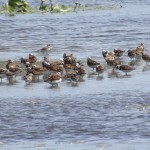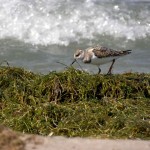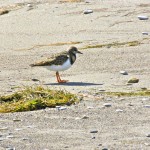2 August 2013. Hamilton ON. It’s a jarring paradox that some of our best birding opportunities are found in some of the ugliest of places. Hamilton Harbour can be a nasty place, sandwiched between a six lane highway and the gritty and grimy edges of a city that prospered from producing steel. The harbour has many inlets, tributaries, hard edges, wharves and mud banks, but if you turn your back on the industrial sectors, it becomes almost gracious particularly along its west side where it borders quiet, green neighbourhoods where house prices, even with a view of blast furnaces, are chillingly high.
It’s at one of the smellier, squishy ends of the harbour that birders and shorebirds flock in late summer. Shorebirds stop here to refuel on their journey from the Arctic where they nested (or perhaps more accurately failed to nest, which may account for why some appear so early.) The outflow from the city’s sewage plant discharges into the harbour and in a project designed to ameliorate the worst of conditions and at the same time provide recreational opportunities (!), the city has created a system of impoundments, marshes, islands and settling ponds, it’s these that the birds find so attractive.
Where there’s muck there’s invertebrates, and where there’s invertebrates there’ll be birds to eat them. Chacun a son goût.
This morning before anyone else in the house was about, I went to see what I could find and identify. Viewed over long distances, shorebirds can be very challenging, there are many lookalikes and subtle colour and size differences are often hard to determine. Still it was quite rewarding despite the scratchy plants around my ankles, rich odours and traffic roar. An island in the middle distance is home to a large colony of Common Terns and some are still busy feeding hungry youngsters. Scouring the edges I found several Lesser Yellowlegs, Least Sandpipers and (with some help) a Stilt Sandpiper and two Semi-palmated Plovers. My best bird, seen briefly and spotted running up the stony banks of the terns’ island was a Ruddy Turnstone.
Two years ago I spent two weeks at a bird observatory at Long Point, Ontario. Ruddy Turnstones were a dime a dozen there. You had to admire them not just for their beauty and approachability, but for their heavy diet of Stable Flies, a nasty biting fly which swarmed in the decaying windrows of wave-tossed aquatic vegetation along the shore.
Today’s bird was still brightly marked in breeding plumage, a lucky sighting because in short order they will moult to a less striking though still elegant plumage for the winter months ahead. The Ruddy Turnstone is probably the most colourful and dramatically marked shorebird of the northern hemisphere although the American Avocet or Eurasia’s Lapwing might be considered rivals. You’d wonder why some shorebirds can be so cryptically coloured while others are almost splashy in their finery. I suspect the answer is that even a dramatic, and to us exuberant, plumage is exactly the right camouflage for a bird on its nest.


